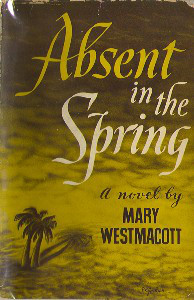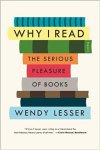Rating: 4.5 out of 5
Year of Publication: 1944
Motive for Murder: None
Plot:
Tell Abu Hamid, November 1936. Joan Scudamore has missed her train connection to Stanboul. Being stuck in a remote rest house, she is faced with unprecedented circumstances which delays her return to London.

1944’s the US book jacket ofFarrar and Rinehart NY.
Two days turn four; the wadi flood has rendered the rail tracks impassable. Breathing the healing air of the Syrian desert, she finds herself rejuvenated in the serene surroundings. Her mind begins to recollect the past events; the words of an old school friend she has bumped into at Baghdad are playing reels of reminiscences in her head. To her astonishment subconscious thoughts surge forward, which lead to her asking herself questions she has never done before.
Did she a devoted wife to Rodney, a dedicated mother to Averil, Tony and Barbara and a good person she had believed?
Highlights:
From you I have been absent in the spring
When proud-piep April, dressed in all his trim,
Hath put a spirit of youth in everything
That heavy Saturn laughed and leapt with him
-Sonnet 98
As Mary Westmacott, Christie cherishes her departure from crime novels. Her fascination about self and the complexity of human mind are the two passions she’s been able to explore under the pseudo name.
For twenty years her other identity is scarcely recognised – even by her ardent fans. For twenty years the six so-called romance books has gained modest successes. Her observation about class and love and changing times in society are woven into the dynamics in self by nurture and through distinctive experience.
Absent In The Spring is the third book published during the War. She finished it in three days straight, of which it has given her such immense pleasure in its process. The manuscript then went to print as it was – as she wished.
In this long monologue of a country lawyer’s wife Christie puts aside her usual style of storytelling. Joan’s self dialogues during her five days’ wait in the lovely warm November sun hardly scratch the surface with the afore-mentioned Shakespeare’s Sonnet.
When Blanche Haggard recognises her school friend at the girls’ boarding school St. Anne’s, her cry ‘holy Moses, it’s Joan!’ is genuine. Off all places; thousands of miles away from the good old England is a face she hasn’t seen for fifteen years. On the other hand, Joan has noticed the girl she once adored first, but has chosen to study her instead.
In portraying the two contrasting personalities – Blanche the carefree, Joan the obliging- through exchanges and remarks, Christie is outlining the ‘picture’ of her protagonist. On the one hand, Joan’s civil responses is the opposite to Blanche’s careless comments about Rodney ‘having a roving eye’ and Barbara ‘too young to be married’ in which Blanche’s insinuating that the young woman did so to get away from home. On the other hand, in spite of Joan’s feeling offended to the other, Blanche’s words set in motion the train of thoughts which persist to continue as they part the next day.
In the subsequent chapters Christie invites her readers to ‘splash some colours’ to Joan. Her mind wandering might be rather unexciting for the first half of the story. Nonetheless, as her seemingly rose-tinted life begins to reveal some cracks, the random collections begin to make sense. Did Rodney miss her? Or was he happy to see her go away? Did Barbara want her mother to come to Baghdad to help her convalesce?
Yet nor the lays of birds, nor the sweet smell
Of different flow’rs in odor and in hue
Could make me any summer’s story to tell,
Or from their proud lap pluck them where they grew

Joan Scudamore lays yellow chrysanthemums on Leslie Rodston’s grave. They means neglected love or sorrow. The Victorian language of flowers are used in the story to convey the truth of a matter.
Joan’s torrents of flashbacks take an unexpected turn, just as a sonnet alters after the eighth line. In the accidental company of an Indian servant whom serves her meals and drinks, his simple take on life makes her rethink her self image. Their limited exchange of words expresses a gentle phase of change in her through him; her perceived ideas on how to live a life becomes reconstructed. She questions whether leading a busy life actually an antidote to happiness.
Blanche and the Indian man are like pistons that runs the engine; more than minor characters. Then the advice of Miss Gilbey, the headteacher of St. Anne’s, when she left school, runs in her head: ‘think of others, my dear and not too much of yourself.’
The moment Joan admits the flaws in her judgements; the decisions she’s made as to what’s best for her family, another crack – much bigger than the previous ones- emerge: Rodney’s nonchalant attitude over the years and her marriage that has gone amiss. For quite sometime. As she turns her focus in the aftermath of Rodney’s breakdown, she sees her life differently.
Nor did I wonder at the lily’s white
Nor praise the deep vermillion in the rose,
They were but sweet, but figures of delight,
Drawn after you, you pattern of all those.

Rodney Scudamore is spotted by his wife wearing red rhododendrons on his lapel – the spring flowering species- in the churchyard. An interesting substitute to ‘the deep vermillion in rose’ in the sonnet, for rhododendron means ‘rose’ and ‘tree’ in ancient Greek
In a twist for which Christie has been famous, her clever use of the sonnet for her euphemism to a late-flowering affection is apparent. Joan has worked out herself and declares defeat.
Thus, this is not a story of a woman having an epiphany in her solitude. This is a story of a spectator to an unconsummated love, born from the shared interest in which Joan has no part. The last proud-pied April comes before the devastating May that marks the other woman’s passing.
Yet it seemed it winter still, and,
You away,
As with your shadow I with these did play
Alas, Joan is the Saturn; the winter in Near Eastern that is ‘moving’ towards England. Yet she carries the shadow of the love little did she realise flourish for years under her very eye.
P.S. If any displeasure can be highlighted is the fact that the Baghdad Railway was completed in 1940. Thus, there couldn’t be any trains running beyond Mosul in 1936. Also, Tell Abu Hamid is a small-populated town in the district of ash-Sharqiyah in Egypt (in the eastern side of Jordan valley) and not in Syria as suggested.
Advertisements Share this:




